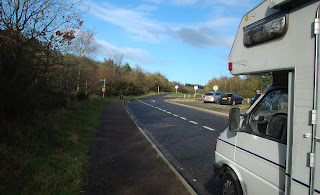Today, from our park at Woburn Road Park, another destination — Wrest Park, whose huge manor house was built by one man, Thomas, Earl de Grey, between 1834 and 1839. He had inherited an outstanding garden with a crumbling medieval house. Rather than restore the house, he had it demolished and built a magnificent new one 200m to the north.
But first we dropped in to McDonald's for a couple of hours to try to catch up on the blog. Not really successful, but we're getting there!
Then, to Wrest Park. The approach, from the town of Silsoe, is magnificent. There is a long straight avenue with playing fields to the north and fields to the south. You come to the wall of what used to be the walled garden, and enter through the Eagle Gateway there. The car parks take up the western part of the walled garden, and a children's playground, the visitor centre, and a not insubstantial walled garden take up the eastern part.
In was a bitterly cold day, but fine. Knowing the vagaries of the English weather, we decided to walk the gardens while it was not raining. (We had already decided to come back here tomorrow to go into the house.)
From the magnificent terrace on the southern side of the house, you look out over the beautiful French parterre gardens, and beyond these, a long walk down to the 'Long Water', and beyond this the pavilion. We walked this walk, from time to time turning back to admire the magnificent vista to the house. The gardens are very symmetrical, and there are statues of classical Greek and Roman subjects all through the grounds.
When you get to the Pavilion, you find a statue of King William III in Roman dress looking back up the Long Water and up to the house.
The pavilion was designed by Thomas Archer, and built between 1709 and 1711, and exemplifies his preoccupation with geometry. The interior is as interesting, having been painted by the French Huguenot artist Louis Hauduroy, using trompe l'œil and grisaille techniques. Spectacular!
We walked back up to the orangery, sitting proudly atop its own embankment. It was built during the re-landscaping of the upper gardens in the 1830s. De Grey based it on a design for a trianon, or grand pavilion, in Blondel's 1737 book Maisons de Plaisance. Once stocked with French orange trees bought from King Louis Phillipe of France, which were wheeled in and out of the orangery as the weather dictated, the building today stands empty, but is used regularly for functions.
We walked back up to the house, but it was getting darker, and colder, so we departed, to return tomorrow.
Distance driven — today, 38 miles ( 61 km ); to date, 30,943 miles ( 49,798 km )
























Another lovely day. Had heard Wyvern (isn't there an Abbey by that name), but didn't know it was a dragon, so my language expands Great gardens-a bit like the Devonshire's ideas i think. Love ya, Keep safe and happy, Cathy.
ReplyDeleteGorgeous wyverns
ReplyDelete